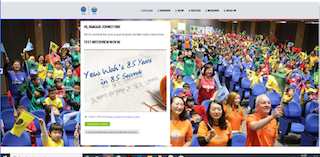 One-way video interviews are a relatively new way to gain insight into a potential candidate’s fit for a role in an international school. At first glance they appear to be incredibly nerve-wracking. The candidate can’t see the interviewer so it can feel very daunting but with some familiarity and preparation, it can be learned. Let’s face it, one way interviews are probably here to stay, especially with more movement towards online learning, it’s definitely worth learning the ropes. At Teacher Horizons we have had a few candidates and schools with experience with one-way video interviews. Read on for our preparatory tips and a very honest first hand account!
One-way video interviews are a relatively new way to gain insight into a potential candidate’s fit for a role in an international school. At first glance they appear to be incredibly nerve-wracking. The candidate can’t see the interviewer so it can feel very daunting but with some familiarity and preparation, it can be learned. Let’s face it, one way interviews are probably here to stay, especially with more movement towards online learning, it’s definitely worth learning the ropes. At Teacher Horizons we have had a few candidates and schools with experience with one-way video interviews. Read on for our preparatory tips and a very honest first hand account!
What is a one-way video interview?
A one-way video interview is where questions are presented to you from the interviewer via video or text. You then record your responses to the questions and the interviewer or HR manager reviews your answers at a different time.
Why do international schools offer one-way video interviews as part of their
recruitment?
According to an experienced international teacher of ours they shared the following: “They’re a useful way to get an initial impression of a candidate that goes beyond what is shared on a CV. Video interviews are an appropriate way to winnow a large field of candidates down to an initial long list for closer consideration.” Which isn’t surprising right now as schools are reducing the amount of candidates flying out for face to face interviews. It’s a good way to avoid wasting time for both parties while gaining that all important first impression!
Honest feedback from international teachers regarding one-way video interviews.
We value transparency at Teacher Horizons so we want to share with you experiences across the spectrum from positive to negative. Perhaps the most daunting parts of one way interviews are the fact that you are unable to see the interviewer and you have a strict time limit to answer. One of our advisers, who has had her own experience being interviewed stated: “It was actually not as bad as I thought it was going to be! I don’t remember the questions offhand, but they were pretty predictable and the timed component forces you to be concise and succinct. It was probably easier than facing their panel in real time further down the line.”
Teacher Horizons works closely with school group YCEF in Hong Kong & mainland China. Our adviser went through the process of the interview platform they use, so they were able to pass on the experiences to the candidates. The school group uses the WePow platform and they have an extensive list of advice on “rocking your interview” on their site.
An adviser of ours shared that the school doesn’t expect the interviewee to be perfectly rehearsed: they just want to gauge the candidates passion and suitability for the role. It’s not all positive feedback though and one candidate shared: “From my perspective, they run counter to the intention of an interview, which is to get to know the individual. There’s just so much that can be learned from the interaction between school leaders and candidates that doesn’t show up in a video interview. Body language, pauses, spontaneous moments of ‘connection’ that only happen when you’re having a conversation in real time – all those are lost in video interviews.”
 Top tips from international teachers on one-way video interviews.
Top tips from international teachers on one-way video interviews.
While they may feel awkward, with preparation you can ace your one way interview! Thank you to one of our teachers for giving us a wonderfully detailed account packed with advice for preparing for the one-way video interview:
Check your environment.
First I’ll set up my interview space. I place the laptop so that it’s filming me at eye level. I make sure I’m in good light, with a window or lamp either behind or to the side of the laptop (never have a window behind you – backlighting is bad). I angle my chair so that I’ve got my back to a blank wall, and I might have some houseplants in the background. This last point may seem common sense, but it bears repeating: I make sure the view doesn’t show details of my home life – dirty dishes or laundry, unmade beds, etc.
Anticipate the questions and topics.
In preparation for video interviews, I try to anticipate the questions and topics I would expect to come up, depending on the position, just as I would for in-person interviews. I’ll write a few key points on post-it notes or in a notebook to have close at hand. These usually match up with points I’ve made in my application letter, or they’ll reference educational thought leaders who shape what I do in schools.
Use a process and repeat it.
Once the video portal reveals a question and the countdown begins, I jot a couple of key words to help me remember the question later, and I make a quick bullet-point outline for my response. I repeat this process for every question in the interview.
 Use post-it notes.
Use post-it notes.
I’ll put those post-it notes around my screen so that I can refer to them throughout the interview while maintaining ‘eye contact’ with the camera. For example, the post might mention Marzano’s instructional strategies, or describing how Hattie or Rosenshine influence my teaching – I can then reference them to cover as broad a spectrum as possible of the things that define my own educational practice.
Record the process for next time.
After the interview, I type every question into a document so that I have a record of questions asked, with reference to the school and positions associated with them. I’ll also include my responses so that I can refine them in preparation for future interviews. Then I take off my coat and tie, breathe deeply, and try to relax.
What kind of questions should international teachers expect in a one-way video interview?
Some of our candidates kindly shared the questions they were asked. This is not an exhaustive list nor does it mean you will get these exact questions, instead please use it as a general guide for preparation and support.
Tell us about yourself.
What aspects of your subject do you find particularly interesting and how do you incorporate this into your lessons?
Can you describe a lesson that you might teach?
Do you think that all students can learn a language and why?
How do you make a positive learning environment?
What inspired you to apply for the current role?
What is your vision as *insert role ?
What is your long term plan?
Logistics & timing.
A couple of teachers shared that after the interview questions they were asked to provide two minutes of additional information: “with each question we were provided three minutes’ worth of time to reply with one minute prep time in between”. Another candidate shared: “There might be an awkward part at the end where it asks you to leave additional comments too!” The time might differ depending on the interviewing system used and the school’s preference. One candidate got the opportunity to check their audio/video and undergo some practice questions first, but it’s uncertain if this is true across the board.
To wrap up: try taking some deep breaths & remember what makes you passionate about teaching— and if you can’t remember glance at those post-it notes! Big thanks to our teachers and advisers for sharing their experiences with such clarity and detail!
What’s your experience with one-way video interviews? Reach out to us at editor@teacherhorizons.com with your stories. While you’re at it you can join the Teacher Horizons community today and be one step closer to your next international teaching job!




